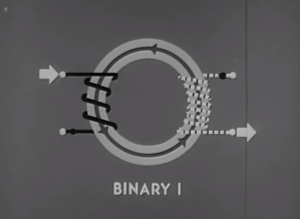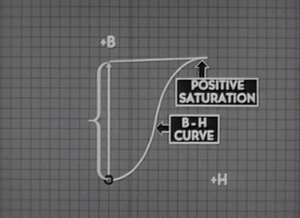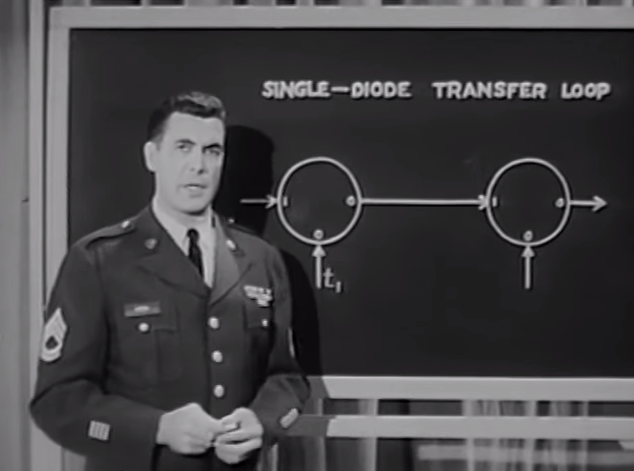As the dashing officer shown above will tell you, early data processing machines and ADP systems employed two types of magnetic cores for memory and other purposes. This 1961 U.S. Army training film is an introduction to the properties of ferrite cores, which are commonly made from nickel alloy and other magnetic materials. As this is only part one of a series, the metallic ribbon type of magnetic core is covered in some other segment we have yet to locate.
The use of magnetic cores for random access memory was built upon transformer theory and provided a rugged and low-power solution until the semiconductor came into vogue. Before that time, the humble ferrite core served many uses and did so very well. The Apollo Guidance Computer had erasable magnetic core memory, and much of its software was stored in core rope memory.
 The film covers a lot of theory and does so clearly and concisely. It begins by explaining what a magnetic core is and why it’s used, and then moves on to describe how the cores are used to store bits and the method by which they can transfer information to other cores. Along the way, it provides background on bi-stable devices and provides explanation of magnetization behavior in terms of magnetizing force and flux density.
The film covers a lot of theory and does so clearly and concisely. It begins by explaining what a magnetic core is and why it’s used, and then moves on to describe how the cores are used to store bits and the method by which they can transfer information to other cores. Along the way, it provides background on bi-stable devices and provides explanation of magnetization behavior in terms of magnetizing force and flux density.
 Essentially, a core can be magnetized in two directions based on the winding’s direction and the end of the conductor at which a current is introduced. The magnetizing force exerted is proportional to the amount of current flowing through it multiplied by the number of turns on the winding. As the magnetic force upon a core increases, the graphed curve showing the relationship between the magnetizing force H and the flux density B eventually flattens out as the saturation point is reached. When the flow of current stops or is reduced, the core material retains most of its magnetism, and this is known as its residual magnetism.
Essentially, a core can be magnetized in two directions based on the winding’s direction and the end of the conductor at which a current is introduced. The magnetizing force exerted is proportional to the amount of current flowing through it multiplied by the number of turns on the winding. As the magnetic force upon a core increases, the graphed curve showing the relationship between the magnetizing force H and the flux density B eventually flattens out as the saturation point is reached. When the flow of current stops or is reduced, the core material retains most of its magnetism, and this is known as its residual magnetism.
In order to overcome the residual magnetism of a core, a certain amount of magnetic force referred to as coercive force is needed. Once this force has brought the flux density back to zero, the curve can move toward the opposite saturation limit. Between these limits, the hysteresis loop can be determined.
In order to influence a second core, the output winding of the first core is linked to the input winding of the second core. A shift winding is introduced on each core to prevent the binary state from switching back to its original value. In closing, the dashing officer will explain the simplified logic diagram representing what you’ve just learned.
http://www.youtube.com/watch?v=X0WnddW5gZI
[Thank you to Martin for sending this in]
Retrotechtacular is a weekly column featuring hacks, technology, and kitsch from ages of yore. Help keep it fresh by sending in your ideas for future installments.

















He’s not an officer, he’s a Sargent, he works for his living
AMEN!!!
Beat me to it…
Don’t you mean, “I’m a Sergeant, my parents were married!”
Beat me to it as well! they could of at least called him an NCO! (Or an SNCO if you’re feeling pedantic)
Do pushups, hackaday!
Sir, yes sir!
Hackaday made a huge mistake, some people are trying to correct them. Why do you have to mock those who actually served in the military? Your response should have been, yes Sergeant how many pushups do you want? FYI if you ever join the military never say sir yes sir if you are not absolutely sure that person is an officer. You will not have a good day, 20 years ago you would have walked away with a broken jaw jaw if you said that in basic training. Today there will be no broken bones, no visible bruises, but I can assure you, that you will not have fun.
Oh, FFS. I was in basic training 22 years ago and no one got a broken jaw (or any other bone) for any reason. I regularly called one of my male COs “ma’am” and all he did was laugh and have me run for a while.
She can write “sir, yes sir” all she wants.
Have a burrito on me . . . sir.
Interesting how you use the word served. Why do you exonerate those that go into the military because of money, something to do, get free trips and shelter? See how stupid that is. Just as only 1% of people that call themselves Christian really are, same thing with the military now days, 1% go because they want to make a difference, and come back realizing they made a terrible mistake. People joined the military in WWII to fight against Hitler, and the tyranny in Europe. Who’s tyrannizing who in Iraq, Afghanistan, etc. Terrorists obviously is the correct answer, and who are terrorists, people that wish to control the population through fear, in order to convert everyone to Islam, and assert control. So unless you disapprove of Islam enough to go to war, then the reasons left to fight, are the said reasons stated above. Now since 1% of population is quite safe to say the percentage of people that go to fight not for themselves but for a cause, is probably less than 5%, again now days. The only reason to go to war, is to defend, not attack, and right now the only thing under attack is Christianity, and the people of said countries. If these people that join the military are such morally stand up people, then why ever join, the biggest threat to the United States right now, is greed, economic inflation, the American culture, and the American dream. I’m curious how joining the military addresses any of the real problems, and the current attacks against the United States. Not including they collect checks from tax payers, during an economic down slide. How the hell does that make sense? I believe all of this truly lays out the real reasons why people join now days. And don’t think about demanding my loyalty/admiration to you or anyone else because you “served” in the military. Righteous judgment is the only right judgment, and until I see you or anyone that demands I give them respect, do something that is rightfully just, or righteous, its not happening. I 100% guarantee the way the United States is conquered is not by an outside force, but the country and its values morph into something else, ie therefore your either the problem or the solution, as it is my judgment that those that join for money, or other stupid/selfish reasons are the problem, same with the uprooting of Christian ethics, morals, and beliefs. Disagree with me? Well good luck with your crap country your creating, and !thanks for conquering/destroying mine
Thank you. Came to say just that.
Sergeant 1st Class to be exact.
Master Sergeant Clipart, if you please!
This is just extremely cool. In 1963, my dad did this and the rest of his IT courses at Keesler AFB. Lived in piles of old tv’s converted to monitors and greenbar paper for years afterward, and he thought anybody who couldn’t code in assembler was a wuss, lol. Later, he wrote the first-ever ride share software, and first racehorse breeding and odds software. Thanks, Sgt. Daddy-san! Thanks, USAF!
This one again last year this exact same thing was posted Hello FILLER.
You sure about that champ? I can’t find a link to this video elsewhere on Hackaday, and I have access to a halfway decent search.
Well I am 100% sure you have posted it before. Not that I’m complaining.
They posted other Army instructional videos, but not that one that I can remember.
Sure, HaD does eventually repost some stuff, but I can’t find this one. You may have mistaken it for some other Retrotechtacular article.
Or this one or this one or even this one.
If Dave was pointing out similar posts, and not the repost that I was mentioning, I think he should also rant on all raspberry pi, and arduino articles here.
couldn’t they be used as a tertiary stable device by ‘magnetizing’ it in both directions at once for a third state?
http://en.wikipedia.org/wiki/Ferroelectric_RAM
Retro may also be new-school
Am I dumb, or have people just gotten WAY worse at explaining things over the years. I’ve watched a number of these retro-tacular “how things work” videos now and I *NEVER* had anything explained to me this well in 4 years of engineering school. Not from professors, not from the $100 textbooks – never. I dunno if I’m just incapable of absorbing material from modern-style textbooks or what…
Absolutely love these videos.
I’m definitely backing this. Maybe it is because making these films was expensive and they had to serve their purpose, so someone thought very carefully about how the topic should be explained as clearly as possible on not too much pelicule. Professors and textbooks can learn some!
I think part of the problem is instructors/teachers/professors have become too concerned about being “cool” and getting good student reviews. Learning has become too laid back as well. When I was an army instructor, we did things by the book: covered only the necessary facts and saved the hypothetical questions and BS for after class. Our students were required to sit still, pay attention and be respectful. Nobody was expected to be silent, questions and requests for clarification were encouraged as long as they didn’t interfere with the class. They weren’t afraid of being beaten or ridiculed either because that’s not how the army does its training.
Like the Michael said, these films were made for one purpose only, to teach the subject there-in. No funny animation, jokes, asides, tangents or reference humor. Just raw instruction.
I think you have some good points, but miss the forest for the trees on the larger issue.
First off, unless you are still in the army, you aren’t seeing the instruction they’re actually using; you’re seeing the stuff that’s either unimportant enough to release to the public, or the stuff specifically tailored for PR or recruiting purposes. The same goes for general education: any information you have is going to be second hand either from kids (who obviously aren’t objective observers) or from the media, which has its own issues.
Which brings me to what I believe is the larger problem you’re seeing: the rise of modern, sophisticated market research and marketing techniques has led to media being tailored for broad appeal at the cost of effectiveness in the ostensible purpose for the media.
In other words, capitalism has taken information and replaced it with infotainment.
You missed his point entirely, he’s not talking about information gained second hand, but first hand. And he’s also not talking about the media, but the direct profs and schools teaching material. Your argument is completely erroneous, and literally has nothing to do with anything said.
horses for courses, if i had to learn at the speed of this video i’d be bored about 2:51 minutes in, which is where i’m writing this comment.. very slow delivery
Please consider that the video isn’t intended for you. It was created to train new techs, not old hands. Chances are quite good that the viewers were mowing lawns, delivering groceries, or pizza, going to high school, or practicing some other late-teens/early-20’s profession six months before seeing this video.
I’ve thought this same exact thing, but a major thing I notice is music, voice and sound. Every instructional video from these days is clear, precise, the voice over is exacting, and specific, and no music or sound that’s not pertinent. While current instructional videos are the reversal, lots of animations, lots of sounds, lots of music, especially background, and the voice over isn’t precise and clear, and talking in one direction.
He is a SFC (sergeant first class). He works for a living.
You are the second person to note that “he works for a living”… Where does this come from and what does it mean regarding sergeants and other officers??
It’s a saying amongst enlisted personnel to correct junior enlisted Soldiers when they call their sergeants “sir.” It’s a breach of basic military protocol to refer to an a sergeant as “sir” or “ma’am,” or for enlisted personnel to salute them. Non-commissioned officers (NCOs, enlisted leaders, sergeants) say this to imply that officers (commissioned officers) have “cushier” jobs – IE, they work for a living, officers do not. The full saying goes, “Don’t call me sir / salute me, I work for a living.”
YES FIRST SERGEANT!
EEVBLOG video of a vintage magnetic core memory board from Siemens
http://www.youtube.com/watch?v=ofCXpIuFhno#t=1488
embed codes dont work for specific time in a video….
For magnetic core memory board, watch from 25 min mark on.
Is it me, or are all the magnetic fields going the wrong direction in the diagrams?
I haven’t watched the video yet, but maybe he isn’t using conventional current. If you use the right hand rule, the direction on the still photo is backwards. Not everybody has always used positive current flow. (Last I heard the USN and physicists still refuse to do so.)
Ah, okay. That would definitely explain it.Thanks.
Got out of USN in 2012. They use both depending on what you are looking at. Made motor/gen theory and discrete a pain to work through. Doublespeak if you will.
So I’m not the only one! I have been wondering if I can still tell which is my right hand for a while
All magnetic core memory components used in production computers had their wires threaded by hand.
A machine was invented to do the job, just in time for silicon RAM chips to make magnetic core RAM obsolete. Would be interesting to know if that machine still exists.
But some mag core systems hung around for a while. The original flight computers on the space shuttles used mag core because they’d been built early on in the development and the project dragged on for so many years. Without all the political infighting the Shuttles would have been flying many years before the 80’s.
Check out that guys youtube channel, he got more awesome videos =)
Check out plated-wire memory for a more modern iteration of the idea. Both technologies offer greater radiation immunity which can be very useful in satellites.
I don’t get it… at 19:00 he says that the second core cannot be changed to 0 due to the diode.
At 20:56 he now says that the current flow would set the second core to zero. How can that same current flow now set the second core to 0 while there is still the diode which would prevent current flow? Is that a mistake?
Watched it again. I belive you are right and this is actually a mistake.
As far as i understand this stuff, the current to swich a core to zero can only come via the shift winding or the input of the cain.
Quite a good explaination on a use of magnetic cores i have never heared of before. So far i only knew of cores used as RAM.
However, at the moment they started to connect two cores together i got confused on _what_ they are actually trying to achieve there. Which is a major problem in any explaination for me. I think you first need to explain what you try to do, then how to do it. This is still true today.
In case someone did not get it: They basically built a shift register (or FIFO memory).
There was also some confusion on my side, because they only talked about transferring ones, never about zeros. A shift winding pulse on a core in zero state just does nothing at all.
Of course just transferring ones makes no sense.
The key to transferring a stream of ones and zeros lies, AFAICT, in the order of pulsing the shift windings. If you wire the cores in series as they did, you need to pulse the shift windings in the opposite direction of dataflow. Rightmost one first, leftmost last.
Because shifting a one out of a core into the next leaves behind a zero, a meaningful information flow can be generated. A zero does not need to transferred in from the previous core, if that happens to have one stored, because it is already there. A tansfer is only needed if the previous core contains a one.